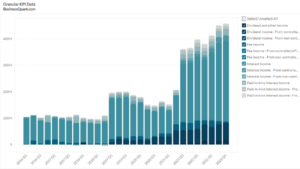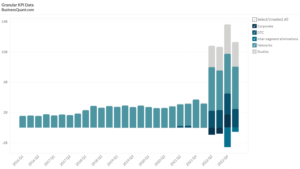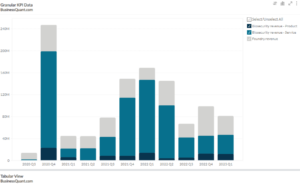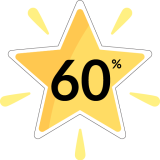
Citigroup’s Revenue Breakdown (2016 – 2023)
Exclusive Data
You need the Pro Plan to access KPI data
- Full access to the platform
- KPI data & segment financials on US stocks
- Financial data on thousands of stocks
- Download data in xlsx and csv formats
Pro Plan
$49 per month*
60% discount ends in:
.
About
More information
Subscribe to Pro or Enterprise plans to unlock this feature.
Contact the Analyst
Subscribe to Pro or Enterprise plans to unlock this feature.
Become a smarter investor today.
Access KPIs & Segment Financials on US stocks
This statistic highlights Citigroup’s Revenue Breakdown from Q1 2016 onwards, split between Net Interest Revenue and Non-Interest Revenue.
Citigroup’s Revenue Breakdown
| Segment | Q3 2020 | Q2 2021 | Q3 2021 | Revenue Contribution in Q3 2021 |
| Net Interest Revenue | 10.493 | 10.199 | 10.398 | 61% |
| Non-interest revenue | 6.809 | 7.275 | 6,756 | 39% |
| Total | 17.302 | 17.474 | 17.154 | 100% |
(All figures in billions except percentages)
The revenue breakdown for Q3 2021 reflects Net Interest Revenue of $10.4 billion and Non-Interest Revenue of $6.76 billion.
1. Net Interest Revenue
Net interest revenue is the difference between interest received on assets retained and interest paid on long and short-term debt and to customers on deposits. In other words, it is the difference between the yield earned on non-trading portfolio assets (including client loans) and the rate paid on liabilities for interest rate exposure reasons (including customer deposits or company borrowings).
Factors that affect Net Interest rate includes changes in interest rates, quantity and mix of assets and liabilities, and the timing of contractual and assumed repricing of assets and liabilities to reflect market rates.
2. Non-Interest Revenue
Fees such as deposit and transaction fees, insufficient funds (NSF) fees, annual fees, monthly account service costs, inactivity fees, check and deposit slip fees, and so on make up non-interest revenue for banks and creditors. Penalty costs, such as late fees and over-the-limit fines, are imposed by credit card issuers.
Citigroup’s Net & Non-Interest Revenue
Within markets and securities services, we can see that Citigroup’s non-interest revenues increased in 2019 and 2020, reflecting increased corporate and investor activity, owing to higher volumes, spreads, and volatility, mainly in the first half of the year. Net interest income increased as well, owing to a shift in the mix of trading positions in support of client activity and decreased funding costs.
Due to increased client activity and a more advantageous trading environment, owing to the volatility associated to the pandemic and developments in the past year, non-interest income grew in stock markets, driven by larger principal transactions, commissions, and fee revenues.
Recent Trends & Forecasts:
By examining the existing risks, we can see that Citigroup’s Net Interest revenue would be further compressed if interest rates for loans fell or remained low, while deposit rates remained virtually unchanged. Citi, like other banks, pays interest on deposits based on shorter-term interest rates and earns money on loans based on longer-term interest rates, so a flattening of the interest rate yield curve (e.g., a smaller spread between shorter-term and longer-term interest rates) could hurt net interest revenue.
Market risk (which includes price risk and interest rate risk) is the risk of loss resulting from changes in the value of Citi’s assets and liabilities, as well as reduced net interest revenues, as a result of changes in market variables like interest rates, exchange rates, equity and commodity prices, or credit spreads. Negative convexity of positions, as well as the presence of basis or correlation risks, can compound losses.
About the company:
Citigroup is a global diversified financial service holding company whose businesses offer a broad, yet focused range of financial products and services to consumers, corporations, governments, and institutions, such as consumer banking and credit, wealth management, trade and securities related services, securities brokerage, and corporate and investment banking. Citi has more than 200 million customers and operates in more than 160 countries and jurisdictions. For management reporting purposes, Citigroup is divided into two business segments, namely the Global Consumer Banking (GCB) and Institutional Clients Group (ICG).
Did you like Citigroup’s Revenue Breakdown statistic?
Access more such key performance indicator (KPI) data points, on thousands of US stocks, with Business Quant.
You can get started for free.
More data on US Stocks

Our Plans
Always know what you’ll pay. No hidden costs or surprises.
- Annual
- Monthly
60% discount until this Sunday
Pro
For serious investing
-
Company KPI data Access segment financials, non-GAAP metrics and KPI data from presentations and filings. Examples include financials by segment / region / product category, AT&T's broadband subscriber trends, Tesla's deliveries by model and lots more.
-
Stock research tools Features include : stock screener, stock comparison, industry financials, stock warnings, advanced charting tools, timeseries tables, scatter charts, financial statements, stock reports, SEC filings, stock ratings, institutional and insider ownership data. There are 200+ financial items and ratios on thousands of US stocks.
-
Industry data & tools Access premium operating data on 40+ industries. Examples include market share, smartphone shipments by vendor, subscribers by wireless carrier, historical gold production. There are 20,000+ such statistics.
Enterprise
For tailored workflows
-
All of Pro plan Get unfettered access to all our dashboards and dossiers.
-
Custom built features Get tailored dashboards built specially for you , based on your set of requirements, to simplify your research workflow.
-
Admin billing Back-end documentation support and multi-seat licensing.
* Billed annually, local taxes extra.
60% discount on Annual plan
Pro
For serious investing
-
Company KPI data Access segment financials, non-GAAP metrics and KPI data from presentations and filings. Examples include financials by segment / region / product category, AT&T's broadband subscriber trends, Tesla's deliveries by model and lots more.
-
Stock research tools Features include : stock screener, stock comparison, industry financials, stock warnings, advanced charting tools, timeseries tables, scatter charts, financial statements, stock reports, SEC filings, stock ratings, institutional and insider ownership data. There are 200+ financial items and ratios on thousands of US stocks.
-
Industry data & tools Access premium operating data on 40+ industries. Examples include market share, smartphone shipments by vendor, subscribers by wireless carrier, historical gold production. There are 20,000+ such statistics.
Enterprise
For tailored workflows
-
All of Pro plan Get unfettered access to all our features.
-
Custom built features Get tailored dashboards built specially for you , based on your set of requirements, to simplify your research workflow.
-
Admin billing Back-end documentation support and multi-seat licensing.
* Local taxes extra.






